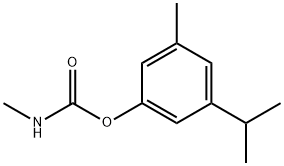Chemical Properties
Promecarb is a colorless, odorless, crystalline
solid
Chemical Properties
Colorless, crystalline solid.
Insoluble in water; soluble in alcohol.
Uses
Promecarb is a carbamate pesticide.
Definition
ChEBI: Promecarb is an alkylbenzene.
General Description
Almost odorless, colorless crystalline solid. Used as a non-systemic contact insecticide. Not for sale or use in the USA.
Reactivity Profile
PROMECARB is a carbamate ester. Carbamates are chemically similar to, but more reactive than amides. Like amides they form polymers such as polyurethane resins. Carbamates are incompatible with strong acids and bases, and especially incompatible with strong reducing agents such as hydrides. Flammable gaseous hydrogen is produced by the combination of active metals or nitrides with carbamates. Strongly oxidizing acids, peroxides, and hydroperoxides are incompatible with carbamates.
Hazard
Toxic by ingestion.
Health Hazard
PROMECARB is highly toxic by ingestion and is absorbed through the intact skin. It is a reversible cholinesterase inhibitor and its effects are related to action on the nervous sysem.
Fire Hazard
(Non-Specific -- Carbamate Pesticide, Solid, n.o.s.) Container may explode in heat of fire. Fire and runoff from fire control water may produce irritating or poisonous gases. Hydrolyzed by alkalis. Stable. No changes observed on storage for 140 hours at122F.
Potential Exposure
A potential danger to those involved
in the manufacture, formulation or application of this non-
systemic contact insecticide.
Shipping
UN2811 Toxic solids, organic, n.o.s., Hazard
Class: 6.1; Labels: 6.1-Poisonous materials, Technical
Name Required.
Incompatibilities
Alkalis.
Waste Disposal
Small quantities: treat with
alkali and then bury. Large quantities: incineration .
In accordance with 40CFR165, follow recommendations
for the disposal of pesticides and pesticide containers.
Must be disposed properly by following package label
directions or by contacting your local or federal environ-
mental control agency, or by contacting your regional
EPA office.


